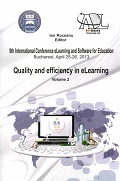ACCEPTANCE AND DIVIDE OF COLLABORATIVE WEB 2.0 LEARNING WITH DIFFERENT SUBJECT DOMAIN ROMANIAN STUDENTS
ACCEPTANCE AND DIVIDE OF COLLABORATIVE WEB 2.0 LEARNING WITH DIFFERENT SUBJECT DOMAIN ROMANIAN STUDENTS
Author(s): Dragoş-Lucian Ivan, Georgiana ChişiuSubject(s): Education
Published by: Carol I National Defence University Publishing House
Keywords: collaborative learning; student interaction; gender
Summary/Abstract: There is a large body of research regarding Web 2.0 supported learning, but most of it seems to start from the hypothesis that collaborative Web 2.0 supported learning can be applied using the same methodology to all subject domains. No study has been conducted on the correlation between gender and the variables of Web 2.0 Anxiety, perceived Web 2.0 efficacy and attitude towards Web 2.0 technology with Romanian students. Another purpose of this research was to test the variables of Web 2.0 anxiety, perceived Web 2.0 efficacy and attitude towards Web 2.0 on students with different subject domain: Engineering (the sample of participants were students from The Polytechnic University ) and Social Sciences (the sample of participants were students from The National School of Political Studies and Public Administration). Following those variables we investigated whether there was a difference in student recall of information or in student interaction. This work explores some methodological challenges in designing a collaborative Web 2.0 learning environment for students with a different subject domain. Quantitative and qualitative results shown in this work illustrate a clearer picture of the design guidelines for classes with a different subject domain. The participants perception on their learning was investigated with surveys and interviews. The purpose is helping instructors design an innovative collaborative Web 2.0 practice that takes into account the difference of the subject domain. Based on these findings, this study suggests that when using collaborative Web 2.0 learning, instructors should consider the characteristics of the subject domain of the student and design their teaching activities accordingly.
Journal: Conference proceedings of »eLearning and Software for Education« (eLSE)
- Issue Year: 9/2013
- Issue No: 02
- Page Range: 430-435
- Page Count: 6
- Language: English

